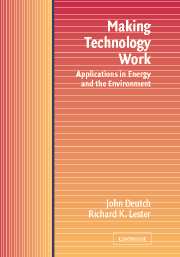Book contents
- Frontmatter
- Contents
- Preface
- 1 Introduction
- 2 Gasohol
- 3 Solar Thermal, Windpower, and Photovoltaic Technologies
- 4 Electricity from Coal
- 5 Controlling Acid Rain from Coal-fired Power Plants
- 6 Greenhouse Gases and Global Warming
- 7 Nuclear Power and Its Fuel Cycle
- 8 Managing Nuclear Waste
- 9 Nuclear Power and Weapons Proliferation
- 10 Natural Gas
- 11 Safety and Risk: Examples from the Liquefied Natural Gas and Nuclear Industries
- 12 Synthetic Fuels
- 13 Fuel Cells For Automobiles
- 14 Energy Models and Statistics
- 15 The Government's Role in Innovation
- 16 Conclusions
- Index
13 - Fuel Cells For Automobiles
Published online by Cambridge University Press: 10 December 2009
- Frontmatter
- Contents
- Preface
- 1 Introduction
- 2 Gasohol
- 3 Solar Thermal, Windpower, and Photovoltaic Technologies
- 4 Electricity from Coal
- 5 Controlling Acid Rain from Coal-fired Power Plants
- 6 Greenhouse Gases and Global Warming
- 7 Nuclear Power and Its Fuel Cycle
- 8 Managing Nuclear Waste
- 9 Nuclear Power and Weapons Proliferation
- 10 Natural Gas
- 11 Safety and Risk: Examples from the Liquefied Natural Gas and Nuclear Industries
- 12 Synthetic Fuels
- 13 Fuel Cells For Automobiles
- 14 Energy Models and Statistics
- 15 The Government's Role in Innovation
- 16 Conclusions
- Index
Summary
In this chapter we discuss fuel cells, an exciting energy technology that many hope will become the (environmentally benign) successor to the internal combustion engine for automobile propulsion. Our study of fuel cells illustrates once again a recurring theme of this book – the importance of properly specifying the system boundary when making technology comparisons. The fuel cell case also reveals several important issues that arise in R&D project management.
As societies around the world become increasingly aware of the environmental consequences of energy supply, distribution and use, there is an understandable wish to invent and deploy new technologies that avoid the costs, both environmental and economic, of the technologies in use today. The desire to find something “new,” that does not have the drawbacks of what is here now and familiar, is invaluable because it is the fundamental driving force of innovation. But good intentions are not the same as successful outcomes, and it is important to insist on disciplined analysis of the technical, economic, and environmental aspects of a new technology before launching expensive new initiatives. This is true for entrepreneurs thinking about starting a new company around a new technology, for an established company considering an expensive new R&D program, or for a government agency considering adopting a new tax, regulatory, or technology development program.
One of the biggest targets in the search for a qualitatively more attractive energy technology is the automobile.
- Type
- Chapter
- Information
- Making Technology WorkApplications in Energy and the Environment, pp. 205 - 220Publisher: Cambridge University PressPrint publication year: 2003



